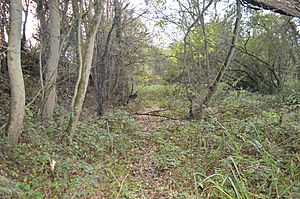Upware South Pit facts for kids
| Site of Special Scientific Interest | |
 |
|
| Area of Search | Cambridgeshire |
|---|---|
| Interest | Geological |
| Area | 1.1 hectares |
| Notification | 1989 |
| Location map | Magic Map |
Upware South Pit is a really cool spot in Cambridgeshire, England. It's a special area, about the size of two football fields, known for its amazing rocks and fossils. Scientists call it a Site of Special Scientific Interest (SSSI) because it helps us learn about Earth's past.
Contents
What Makes Upware South Pit Special?
This site is like a time capsule! The rocks here are super old, dating back about 160 million years. This time is known as the Oxfordian Stage. Imagine, that's even before many dinosaurs walked the Earth!
A Peek into an Ancient Ocean
Millions of years ago, this area wasn't land at all. It was part of a warm, shallow sea, much like a tropical ocean today. This sea was home to a vibrant coral reef. Coral reefs are like underwater cities built by tiny sea creatures.
Fossils from a Lost World
Because it was a coral reef, Upware South Pit is full of amazing fossils. When you visit, you might find:
- Corals: These are the remains of the reef builders themselves.
- Bivalves: These are like ancient clams or oysters. They had two shells that hinged together.
- Ammonites: These look like coiled snail shells, but they were actually sea creatures related to modern-day squids and octopuses.
These fossils are special because they show connections to creatures that lived in a huge ancient ocean called the Tethys Ocean. Studying them helps scientists understand how life and oceans have changed over millions of years. Natural England, a group that protects nature, says this site is super important for learning about the Oxfordian period.
Visiting Upware South Pit
You can explore parts of Upware South Pit! There's a path called the Fen Rivers Way that leads right to the site from the north of Upware. It's a great way to see this unique geological treasure.
A small part of the site, which is grassy, is not open to the public. This area is also part of another special nature spot called the Cam Washes, which is important for its wildlife.

